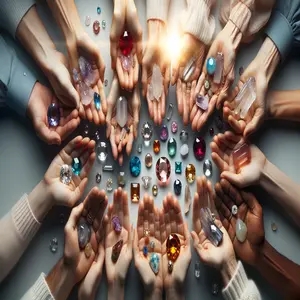What Are Gemstones? Nature's Most Coveted CreationsPosted by eric on October 20th, 2023  Gemstones are naturally occurring minerals or rocks that are prized for their beauty, durability, and rarity. They are often cut and polished to enhance their appearance and are used in jewelry, decorative objects, and other applications. Not all minerals can be gemstones. To be considered a gemstone, a mineral must meet certain criteria, including: Beauty: Gemstones must be visually appealing, with a desirable color, luster, and transparency. Precious vs. Semi-precious: Debunking the MythsThe distinction between precious and semi-precious gemstones is a common one, but it is also a myth. There is no scientific basis for classifying gemstones in this way. The terms "precious" and "semi-precious" are simply marketing terms that are used to distinguish between the most valuable and the less valuable gemstones. Some of the gemstones that are commonly considered to be precious include diamonds, rubies, sapphires, and emeralds. These gemstones are all prized for their rarity, beauty, and durability. However, there are many other gemstones that are just as beautiful and durable, but are not considered to be precious. For example, gemstones such as amethyst, citrine, and topaz are all very valuable and make stunning jewelry pieces. Commonly Known Gemstones and Their Unique PropertiesDiamond: The hardest natural substance on Earth, diamonds are known for their brilliance and sparkle.
There are many rare and lesser-known gemstones that are a collector's dream. Here are a few examples: Alexandrite: A rare gemstone that changes color from green in daylight to red in artificial light. Gemstones have played a significant role in culture and mythology for centuries. They have been used to create beautiful jewelry, decorative objects, and religious artifacts. Gemstones have also been associated with mystical and healing powers. For example, diamonds are often associated with love and commitment. Rubies are associated with passion and energy. Sapphires are associated with royalty and wisdom. Emeralds are associated with healing and rebirth. Gemstones continue to fascinate and inspire people today. They are a reminder of the beauty and diversity of the natural world. Gemstones in Ancient CivilizationsGemstones have been prized by humans for centuries. In ancient civilizations, they were used for a variety of purposes, including adornment, talismans, and healing. Adornment Gemstones were used to create beautiful jewelry for both men and women in ancient civilizations. They were also used to decorate clothing and other objects. Talismans Gemstones were also believed to have magical powers and were used as talismans to protect the wearer from harm or to bring good luck. For example, lapis lazuli was believed to be a powerful talisman in ancient Egypt. Healing Gemstones were also used for healing in ancient civilizations. Different gemstones were believed to have different healing properties. For example, emeralds were believed to be good for the eyes and rubies were believed to be good for the heart. Folklore and Legends Many popular gemstones have their own folklore and legends associated with them. For example, diamonds are often associated with love and commitment. Rubies are associated with passion and energy. Sapphires are associated with royalty and wisdom. Emeralds are associated with healing and rebirth. Spiritual Properties Gemstones are also believed to have spiritual properties. Different gemstones are associated with different energies and chakras. For example, amethyst is associated with the third eye chakra, which is associated with intuition and wisdom. Rose quartz is associated with the heart chakra, which is associated with love and compassion. Gemstone Grading Gemstones are graded based on a variety of factors, including color, clarity, cut, and carat. Color is the most important factor in determining the value of a gemstone. Clarity refers to the number and size of inclusions in a gemstone. Cut refers to the way that a gemstone is shaped and polished. Carat is the weight of a gemstone. Caring for Your Gemstones
|


